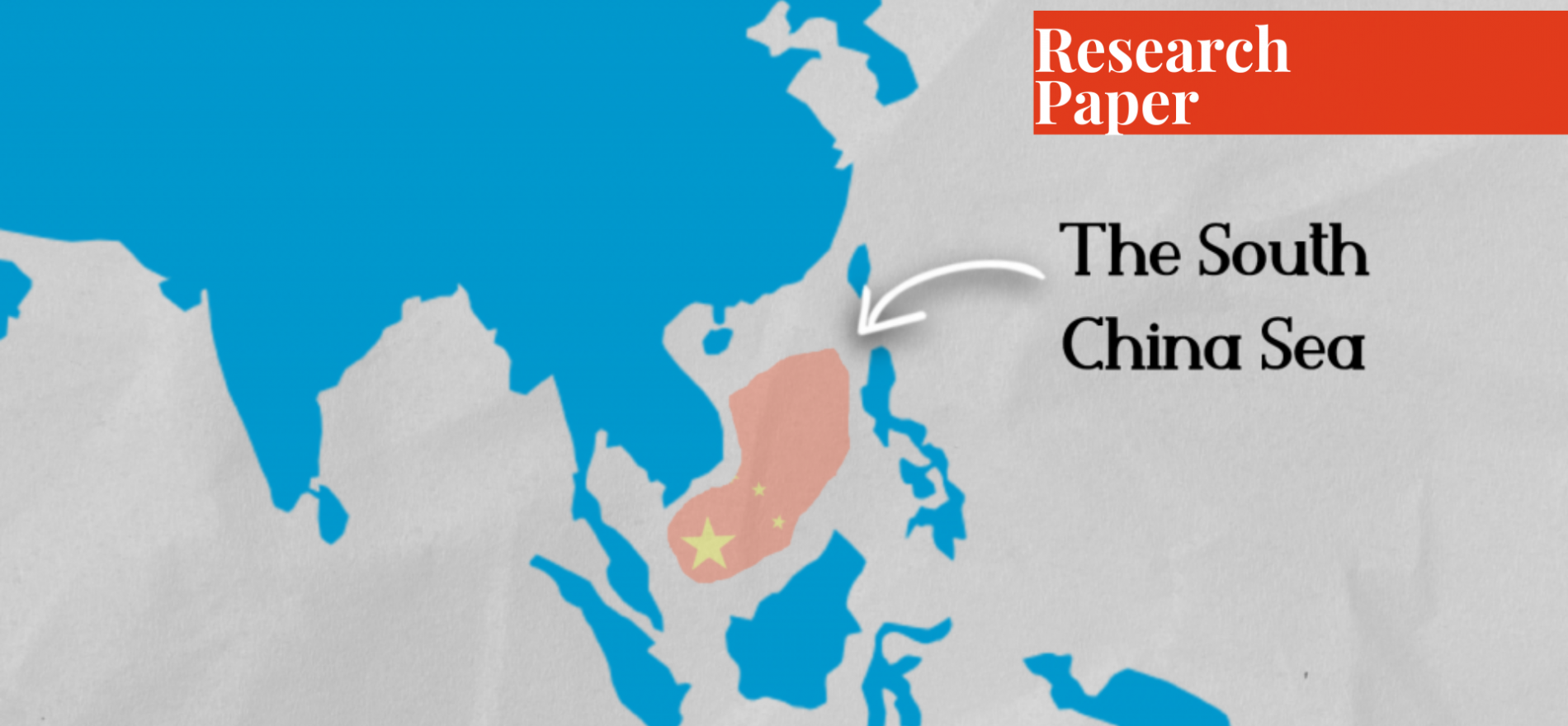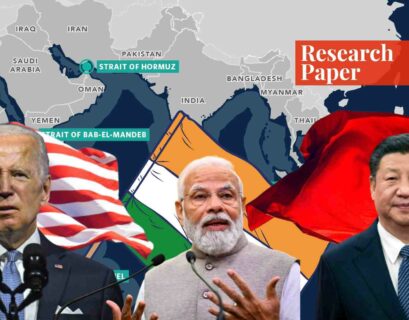Introduction
The South China Sea is important due to economic, military, and strategic factors. Furthermore, this region, critical for military purposes, is rich in resources like oil and gas reserves in its continental shelves and seabed. Considering the geography of the South China Sea, it can be observed that it starts from Singapore to Taiwan Strait, covering an area of 1.4 million square miles. Most of the regional states have claims over this territory and waters of the South China Sea, making it one of the most controversial and contested regions in the world. The most powerful actor in the region is obviously China which has ambitious plans in the South China Sea – the other smaller states, conversely, take exception to Chinese policies and actions in the region. Besides regional states, countries like America also have an issue with Chinese expansionism in the region and this marks a major dispute in the South China Sea.
Maritime can be said to be of immense significance with reference to the South China Sea, since several actors have an involvement thereof,1 namely Taiwan, China, Philippines, Indonesia, Thailand, Malaysia, Vietnam, and Cambodia. The primary issue revolves around the islands that are abundant in resources. However, China, being the regional power, is steadily gaining ascendancy over these disputed islands. China is claiming the exclusive economic zones — the area allotted by the United Nations under the law of seas, which permits the states to regulate their rights regarding the use of natural resources and exploration from their baselines to 200 nautical miles of their coasts — which are interconnected with Vietnam, Philippines, Malaysia, and Brunei.
Strategically, this region has much importance because this region is considered as the hub of economic maritime passages from West to East. Sea lines of communication (SLOC) of this region are considered as the key routes for international trade. According to a report, goods worth about $5 trillion flow through these waters.2 Other than that, the seabed contains 11 billion barrels of oil and 190 trillion cubic feet of natural gas.3 It is also being said that the one who would control this region, will control the whole of Asia. It is so because more than 80% of Asian trade passes through this region.
Historical Background
The South China Sea used to be a historical fishing point for China, Vietnam, Malaysia, and the Philippines. China’s nine-dash line concept is its historical claim over a demarcated area in the South China Sea. Since then, China is working to gain those areas and making military installations in these regions like artificial islands and airstrips. China has also occupied the Vietnamese garrison and Paracel Islands despite the claims of Taiwan and Vietnam over them. Later, in 1988 there was a confrontation between the Chinese and Vietnamese armies due to these islands.
In order to resolve the issues, the Declaration on the Conduct of Parties in the South China Sea was signed in 2002 between the People’s Republic of China and the Association of Southeast Asian Nations (ASEAN). In this agreement, it was declared that the states concerned must “resolve their territorial and jurisdictional disputes by peaceful means, without resorting to the threat or use of force, through friendly consultations and negotiations.”4
China’s Assertive Behaviour in the South China Sea
The South China Sea is about 1.4 million sq. miles and is composed of several islands, reefs, and rocks, which are part of the Paracel Islands and the Spratly Islands. These islands are claimed by all six regional states as areas under their sovereignty. China has adopted a strict policy regarding the South China Sea, declaring it as a non-negotiable territory because of its claim over it. China has asserted it as a “core national interest” and advised the regional states not to discuss this issue. This same term was used by China for its issues in Taiwan, Tibet, and Xinjiang province. China is taking pre-emptive measures and is showing revisionist behaviour in the region.
China’s aggressive behaviour is escalating with every event. It has declared its “historical” as well as “legal” claims over the South China Sea. Historically, China proved this region to be under the control of its sovereignty since the last two millennia. Due to its self-claimed sovereignty, China has also stopped the Vietnamese vessel in the South China Sea that was on the route for oil exploration. To support its claims, China has built artificial islands, installed military in the region through military bases, and is doing naval exercises in the region. To strengthen its claims, China has also taken hasty decisions to build reefs in the Islands of Paracel and the Spratly Islands in 2011.
In addition to all these, China has also built a strong air defence system in which surface-to-air defence system is applied on Woody Islands and it has also constructed helipads on Duncan Islands and Paracel Islands. Considering the military installations on the Woody Islands, it includes sixteen J-11 fighters, a munitions storage facility, and an airstrip of about 2,700 meters long. The main purpose of these instalments is to ensure its national security and to have an eye over America involvements and activities in its neighbouring region. In 2016, the UN Convention on Laws of the Sea rejected Chinese claims over the extended exclusive economic zones and the nine-dash line.
The UN Convention has also rejected China’s historical claims over these waters and allowed the American Navy to carry out its military exercises and surveillance flights over the South China Sea. Along with the USA, smaller states of this region also got the benefit to exploit the natural resources, the hydrocarbon, and fish in these waters.5 Scarborough Shoal, a constant bone of contention between China and the Philippines since 1997, is considered the coral atoll in the whole of the South China Sea. The region contains a vast amount of resources such as fisheries, guano, sea cucumbers, and other exotic kinds of aquatic life.
China and the Philippines had a major stand-off when a military vessel of the Philippines threatened the Chinese fishermen in the Shoal. As a result, China retaliated quickly, sending two huge maritime surveillance vessels to confront the Filipino ship from carrying out its operation. In the following weeks, China not only refused to withdraw its vessels, but it also sent many of its vessels to maintain a permanent guard around the atoll, which blocked any kind of entry into the atoll’s lagoon. As the aftermath of this episode, the Philippines eventually withdrew its ships.
The Philippines then accused that the Chinese navy took control of the Scarborough Shoal.6 China negated the accusation, maintaining that the case went beyond the jurisdiction of the court and that it would not accept the decision.7 China rejected the verdict soon after it was issued, calling it “ill-founded”. The Chinese President, Xi Jinping, said that China’s “territorial sovereignty and marine rights” in the seas may not be affected by the ruling. He maintained that China was still “committed to resolving disputes” with its neighbors.8
USA’s Involvement in the South China Sea
In this region, the U.S.’s intentions and interests are transparent: by ensuring free navigations through these sea lines of communication (SLOC), the US economy would benefit; the free flow of maritime trade through the SLOC would be crucial to the American economy.9 Strategically, this region is also suitable for transportation purposes from the Pacific to the Indian Ocean. Due to the historical and current involvement of the U.S. in the region, China assumes it as the projection of power by the United States. The U.S. has installed its military in the region and built naval bases in regional states including South Korea and Japan.
The United States has also installed a nuclear submarine fleet and has projected its power by installing its fleets in the Philippines and Australia.10 The military presence of the US in the region has lead to a security dilemma for China, since the South China Sea is the region where China is the sole regional power. In 2016, China, feeling threatened by the United States’ warship, attacked and destroyed the said warship that was sailing within the 12 nautical miles of one of the artificially-built islands by China. The US considered it a violation of “freedom of navigation and exercises”. Similarly, in December 2016, China seized a U.S. drone submarine, prompting another heated conflict between the two major powers.
Regional Implications
China’s revisionist behaviour in the region is resulting in a regional security dilemma; states are beginning to feel a sense of threat from China’s aggressive policies — for instance, its naval build-up — and hence are engaging in heightened militarization. Due to the aggressive behaviour of China, almost all the ASEAN states have adopted a more competitive and defensive foreign policy. In order to resolve this issue, the Philippines has proposed the concept of liberal ideas concerning the extension of territorial claims.
Conflicts must be resolved according to the multilateral and international laws instead of a realistic approach such as “might is right”. As the world’s fastest-growing economy, China’s realistic behaviour has prompted neighboring states to reinforce their militarization. It is believed that if China were to gain control of the whole region, its economy would boost up to at double rates; this economic strength, of course, would compound its military strength. Such would elevate China as a competitor of the U.S., thus signaling a threat to the U.S.’s position as the supreme power, and so the U.S. will take every possible step to counter China’s influence in the world.
The Philippines is displaying the suitable tactic for solving disagreements concerning overlapping claims should be through a liberal and legal approach based on multilateralism and international law, rather than a “might makes right” realpolitik strategy. These power struggles between China and the U.S. would prompt Vietnam to increase its military muscles quantitatively as well as qualitatively. With Russia’s assistance, Vietnam has already built diesel-electric submarines and a modern anti-ship missile system.
At the same time, the Philippines is also moving towards military modernization, doubling its fleets of the surface combatants, and pursuing to modernize its frigates. Malaysia has started its naval build-up in the region; it is also working to build two self-made frigates and has acquired two improved South Korean submarines.11 Meanwhile, the United States progressively behaves according to the logic of realpolitik, building a regional alliance in what increasingly appears as an attempt to contain China’s emergence as a superpower. Nevertheless, the rise in military spending cannot be considered a good omen when it comes to regional peace and stability.
Conclusion
The exclusivity of the South China Sea is the reason for its devastation and competition. The competition over these natural resources has ruined the peace of the region. China, which previously followed a benign foreign policy, and believed in win-win cooperation rather than absolute gains, has also become a victim of the lust for resources. With the feeling of insecurity pervading due to the presence and influence of USA in the region, China is adopting aggressive policies, which, in turn, could subvert its influence.
The other states contesting over the South China Sea are intending to become allies with the U.S., which, then, creates a space for the American forces to intervene. The U.S., too, has economic, security, strategic, and military-related interests in the aforesaid region. To counter the Chinese emergence, the U.S.’s presence in the region is ensured by its allies. China, like every state, maintains the need for peace and liberal values, but such sacrosanct principles are disregarded in the face of national security.
Endnotes
1 Micah S. Muscolino, “Past and Present Resource Disputes in the South China Sea: The Case of Reed Bank,” Cross-Currents: East Asian History and Culture Review, no. 8 (2013), 447-477. .
2 U.S. Energy Information Administration, “South China Sea,” last modified October 15, 2019, https://www.eia.gov/international/content/analysis/regions_of_interest/South_China_Sea/south_china_sea.pdf.
3 U.S. Energy Information Administration, “South China Sea.”
4 Brian Kalman, “Growing Militarization of the South China Sea, US-China Confrontation,” last modified April 18, 2016, https://www.globalresearch.ca/growing-militarization-of-the-south-china-sea-us-china-confrontation/5520564.
5 Todd H. Hall, “Map: What’s at issue in the South China Sea Dispute?” The Washington Post, July 12, 2016, https://www.washingtonpost.com/news/worldviews/wp/2016/07/12/map-whats-at-issue-in-the-south-china-sea-dispute/.
6 Hall, “Map: What’s at issue in the South China Sea Dispute?”
7 Ben Westcott, “Philippines vs China: Why the South China Sea ruling may change Asia,” CNN, July 12, 2016, https://edition.cnn.com/2016/07/04/asia/south-china-sea-un-case-explainer/index.html.
8 Tom Phillips, Oliver Holmes, and Owen Bowcott, “Beijing rejects tribunal’s ruling in South China Sea case,” The Guardian, July 12, 2016, https://www.theguardian.com/world/2016/jul/12/philippines-wins-south-china-sea-case-against-china.
9 U.S. Department of the Navy, U.S. Marine Corps, and U.S. Coast Guard, ‘‘Naval Operations Concept 2010: Implementing the Maritime Strategy,’’ 35. https://fas.org/irp/doddir/navy/noc2010.pdf.
10 John Rennie Short, ‘‘Troubled waters: conflict in the South China Sea explained,’’ The Conversation, July 12, 2016, https://theconversation.com/troubled-waters-conflict-in-the-south-china-sea-explained-59203#:~:text=There%20are%20a%20number%20of,and%20undermined%20China%2DVietnam%20relations..
11 Steven Stashwick, ‘‘Naval Buildups in the South China Sea,’’ The Diplomat, July 15, 2015, https://thediplomat.com/2015/07/naval-buildups-in-the-south-china-sea/.
Bibliography
- Hall, Todd H. “Map: What’s at issue in the South China Sea Dispute?” The Washington Post, July 12, 2016. https://www.washingtonpost.com/news/worldviews/wp/2016/07/12/map-whats-at-issue-in-the-south-china-sea-dispute/.
- Kalman, Brian. “Growing Militarization of the South China Sea, US-China Confrontation.” Last modified April 18, 2016, https://www.globalresearch.ca/growing-militarization-of-the-south-china-sea-us-china-confrontation/5520564.
- Muscolino, Micah S. “Past and Present Resource Disputes in the South China Sea: The Case of Reed Bank.” Cross-Currents: East Asian History and Culture Review, no. 8 (2013), 447-477. .
- Phillips, Tom., Oliver Holmes, and Own Bowcott, “Beijing rejects tribunal’s ruling in South China Sea case.” The Guardian, July 12, 2016. https://www.theguardian.com/world/2016/jul/12/philippines-wins-south-china-sea-case-against-china.
- Short, John Rennie. ‘‘Troubled waters: conflict in the South China Sea explained.’’ The Conversation, July 12, 2016. https://theconversation.com/troubled-waters-conflict-in-the-south-china-sea-explained-59203#:~:text=There%20are%20a%20number%20of,and%20undermined%20China%2DVietnam%20relations...
- Stashwick, Steven. ‘‘Naval Buildups in the South China Sea.’’ The Diplomat, July 15, 2015. https://thediplomat.com/2015/07/naval-buildups-in-the-south-china-sea/.
- U.S. Department of the Navy, U.S. Marine Corps, and U.S. Coast Guard. ‘‘Naval Operations Concept 2010: Implementing the Maritime Strategy.’’ https://fas.org/irp/doddir/navy/noc2010.pdf.
- U.S. Energy Information Administration. “South China Sea.” Last modified October 15, 2019. https://www.eia.gov/international/content/analysis/regions_of_interest/South_China_Sea/south_china_sea.pdf.
- Westcott, Ben. “Philippines vs China: Why the South China Sea ruling may change Asia.” CNN, July 12, 2016. https://edition.cnn.com/2016/07/04/asia/south-china-sea-un-case-explainer/index.html.
If you want to submit your articles and/or research papers, please check the Submissions page.



















